VU Sydney BMO6630: Business Research Methods Reflective Report
VerifiedAdded on 2023/03/17
|6
|1425
|29
Report
AI Summary
This reflective report analyzes the design and implementation of a questionnaire focused on customer perceptions within the boutique restaurant sector. The report details the research objectives, which aimed to understand customer views on servicescape, empathy, and restaurant authenticity. It explains the questionnaire's structure, including the use of both open and closed-ended questions, and discusses the rationale behind each question type. The report also highlights the importance of questionnaire design, emphasizing adherence to criteria such as clear language, relevance to research topics, and consideration for respondent privacy. The student reflects on the development process, including the determination of research aims, definition of the target audience, question optimization, and pilot testing. The report concludes by emphasizing the questionnaire's role in collecting primary data, which will be supported by secondary data in future studies. The report also includes references to related research papers.

Running Head : REFLECTIVE REPORT
Reflective Report
Name of the Student
Name of the University
Author Note
Reflective Report
Name of the Student
Name of the University
Author Note
Paraphrase This Document
Need a fresh take? Get an instant paraphrase of this document with our AI Paraphraser
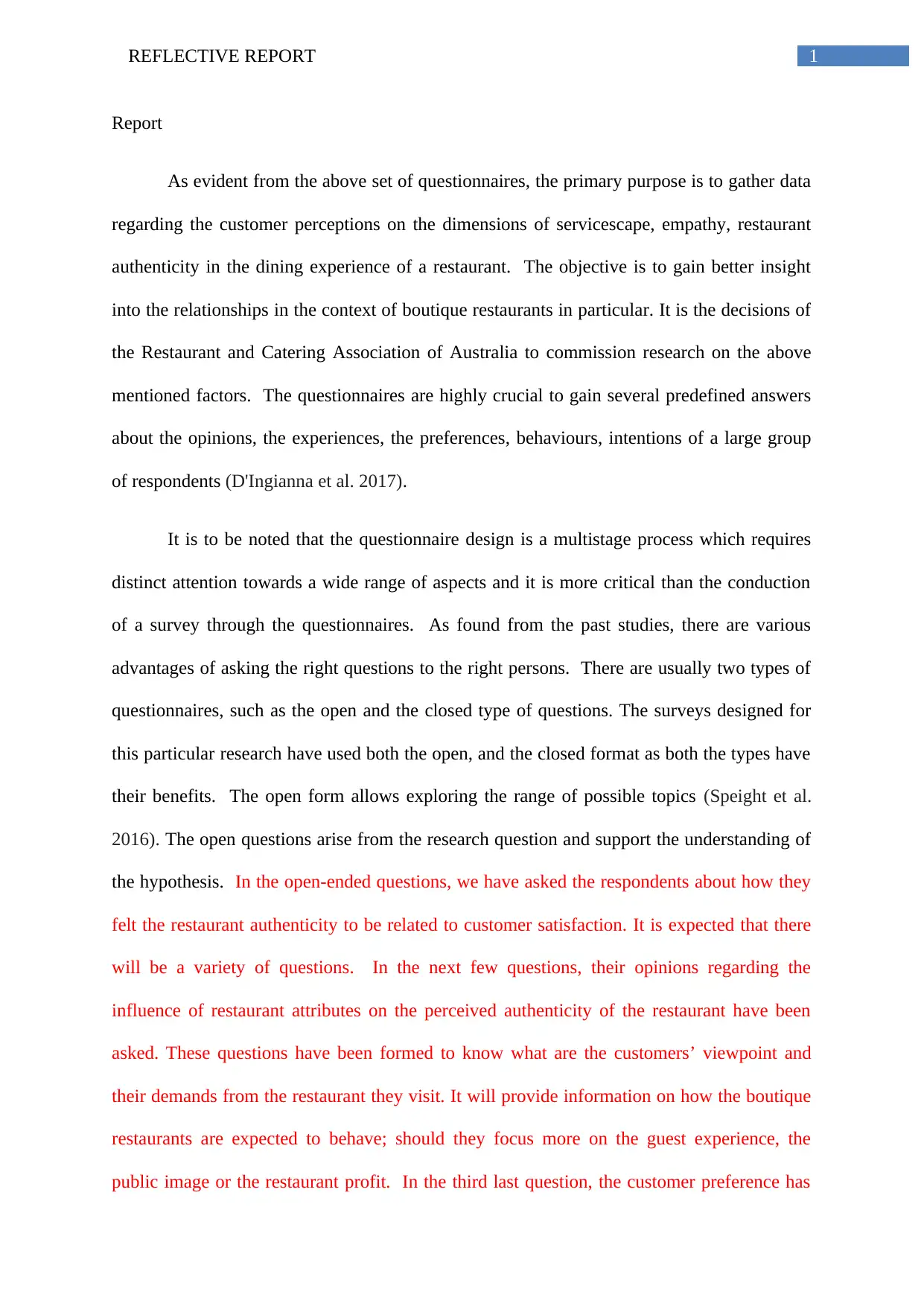
1REFLECTIVE REPORT
Report
As evident from the above set of questionnaires, the primary purpose is to gather data
regarding the customer perceptions on the dimensions of servicescape, empathy, restaurant
authenticity in the dining experience of a restaurant. The objective is to gain better insight
into the relationships in the context of boutique restaurants in particular. It is the decisions of
the Restaurant and Catering Association of Australia to commission research on the above
mentioned factors. The questionnaires are highly crucial to gain several predefined answers
about the opinions, the experiences, the preferences, behaviours, intentions of a large group
of respondents (D'Ingianna et al. 2017).
It is to be noted that the questionnaire design is a multistage process which requires
distinct attention towards a wide range of aspects and it is more critical than the conduction
of a survey through the questionnaires. As found from the past studies, there are various
advantages of asking the right questions to the right persons. There are usually two types of
questionnaires, such as the open and the closed type of questions. The surveys designed for
this particular research have used both the open, and the closed format as both the types have
their benefits. The open form allows exploring the range of possible topics (Speight et al.
2016). The open questions arise from the research question and support the understanding of
the hypothesis. In the open-ended questions, we have asked the respondents about how they
felt the restaurant authenticity to be related to customer satisfaction. It is expected that there
will be a variety of questions. In the next few questions, their opinions regarding the
influence of restaurant attributes on the perceived authenticity of the restaurant have been
asked. These questions have been formed to know what are the customers’ viewpoint and
their demands from the restaurant they visit. It will provide information on how the boutique
restaurants are expected to behave; should they focus more on the guest experience, the
public image or the restaurant profit. In the third last question, the customer preference has
Report
As evident from the above set of questionnaires, the primary purpose is to gather data
regarding the customer perceptions on the dimensions of servicescape, empathy, restaurant
authenticity in the dining experience of a restaurant. The objective is to gain better insight
into the relationships in the context of boutique restaurants in particular. It is the decisions of
the Restaurant and Catering Association of Australia to commission research on the above
mentioned factors. The questionnaires are highly crucial to gain several predefined answers
about the opinions, the experiences, the preferences, behaviours, intentions of a large group
of respondents (D'Ingianna et al. 2017).
It is to be noted that the questionnaire design is a multistage process which requires
distinct attention towards a wide range of aspects and it is more critical than the conduction
of a survey through the questionnaires. As found from the past studies, there are various
advantages of asking the right questions to the right persons. There are usually two types of
questionnaires, such as the open and the closed type of questions. The surveys designed for
this particular research have used both the open, and the closed format as both the types have
their benefits. The open form allows exploring the range of possible topics (Speight et al.
2016). The open questions arise from the research question and support the understanding of
the hypothesis. In the open-ended questions, we have asked the respondents about how they
felt the restaurant authenticity to be related to customer satisfaction. It is expected that there
will be a variety of questions. In the next few questions, their opinions regarding the
influence of restaurant attributes on the perceived authenticity of the restaurant have been
asked. These questions have been formed to know what are the customers’ viewpoint and
their demands from the restaurant they visit. It will provide information on how the boutique
restaurants are expected to behave; should they focus more on the guest experience, the
public image or the restaurant profit. In the third last question, the customer preference has
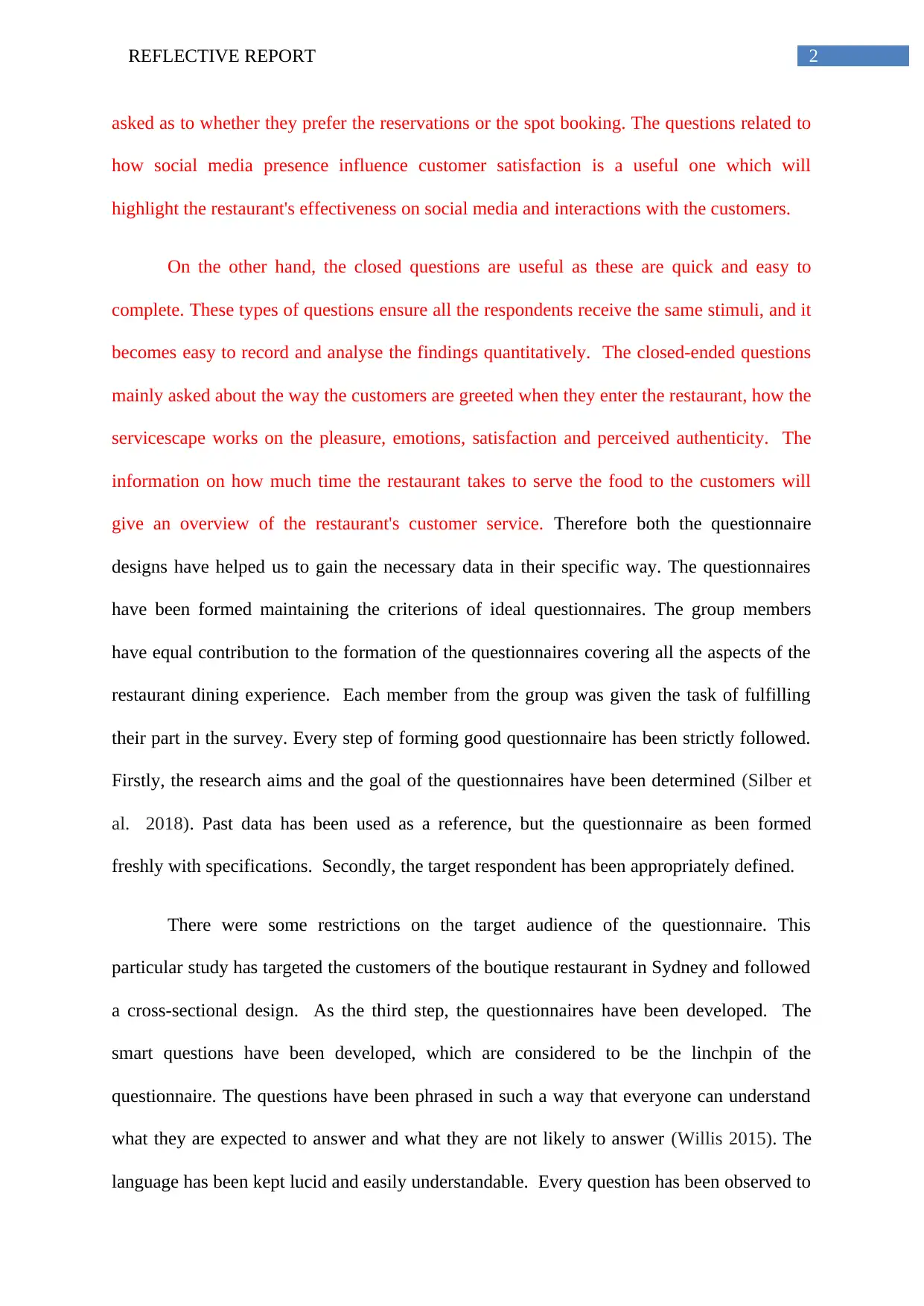
2REFLECTIVE REPORT
asked as to whether they prefer the reservations or the spot booking. The questions related to
how social media presence influence customer satisfaction is a useful one which will
highlight the restaurant's effectiveness on social media and interactions with the customers.
On the other hand, the closed questions are useful as these are quick and easy to
complete. These types of questions ensure all the respondents receive the same stimuli, and it
becomes easy to record and analyse the findings quantitatively. The closed-ended questions
mainly asked about the way the customers are greeted when they enter the restaurant, how the
servicescape works on the pleasure, emotions, satisfaction and perceived authenticity. The
information on how much time the restaurant takes to serve the food to the customers will
give an overview of the restaurant's customer service. Therefore both the questionnaire
designs have helped us to gain the necessary data in their specific way. The questionnaires
have been formed maintaining the criterions of ideal questionnaires. The group members
have equal contribution to the formation of the questionnaires covering all the aspects of the
restaurant dining experience. Each member from the group was given the task of fulfilling
their part in the survey. Every step of forming good questionnaire has been strictly followed.
Firstly, the research aims and the goal of the questionnaires have been determined (Silber et
al. 2018). Past data has been used as a reference, but the questionnaire as been formed
freshly with specifications. Secondly, the target respondent has been appropriately defined.
There were some restrictions on the target audience of the questionnaire. This
particular study has targeted the customers of the boutique restaurant in Sydney and followed
a cross-sectional design. As the third step, the questionnaires have been developed. The
smart questions have been developed, which are considered to be the linchpin of the
questionnaire. The questions have been phrased in such a way that everyone can understand
what they are expected to answer and what they are not likely to answer (Willis 2015). The
language has been kept lucid and easily understandable. Every question has been observed to
asked as to whether they prefer the reservations or the spot booking. The questions related to
how social media presence influence customer satisfaction is a useful one which will
highlight the restaurant's effectiveness on social media and interactions with the customers.
On the other hand, the closed questions are useful as these are quick and easy to
complete. These types of questions ensure all the respondents receive the same stimuli, and it
becomes easy to record and analyse the findings quantitatively. The closed-ended questions
mainly asked about the way the customers are greeted when they enter the restaurant, how the
servicescape works on the pleasure, emotions, satisfaction and perceived authenticity. The
information on how much time the restaurant takes to serve the food to the customers will
give an overview of the restaurant's customer service. Therefore both the questionnaire
designs have helped us to gain the necessary data in their specific way. The questionnaires
have been formed maintaining the criterions of ideal questionnaires. The group members
have equal contribution to the formation of the questionnaires covering all the aspects of the
restaurant dining experience. Each member from the group was given the task of fulfilling
their part in the survey. Every step of forming good questionnaire has been strictly followed.
Firstly, the research aims and the goal of the questionnaires have been determined (Silber et
al. 2018). Past data has been used as a reference, but the questionnaire as been formed
freshly with specifications. Secondly, the target respondent has been appropriately defined.
There were some restrictions on the target audience of the questionnaire. This
particular study has targeted the customers of the boutique restaurant in Sydney and followed
a cross-sectional design. As the third step, the questionnaires have been developed. The
smart questions have been developed, which are considered to be the linchpin of the
questionnaire. The questions have been phrased in such a way that everyone can understand
what they are expected to answer and what they are not likely to answer (Willis 2015). The
language has been kept lucid and easily understandable. Every question has been observed to
⊘ This is a preview!⊘
Do you want full access?
Subscribe today to unlock all pages.

Trusted by 1+ million students worldwide
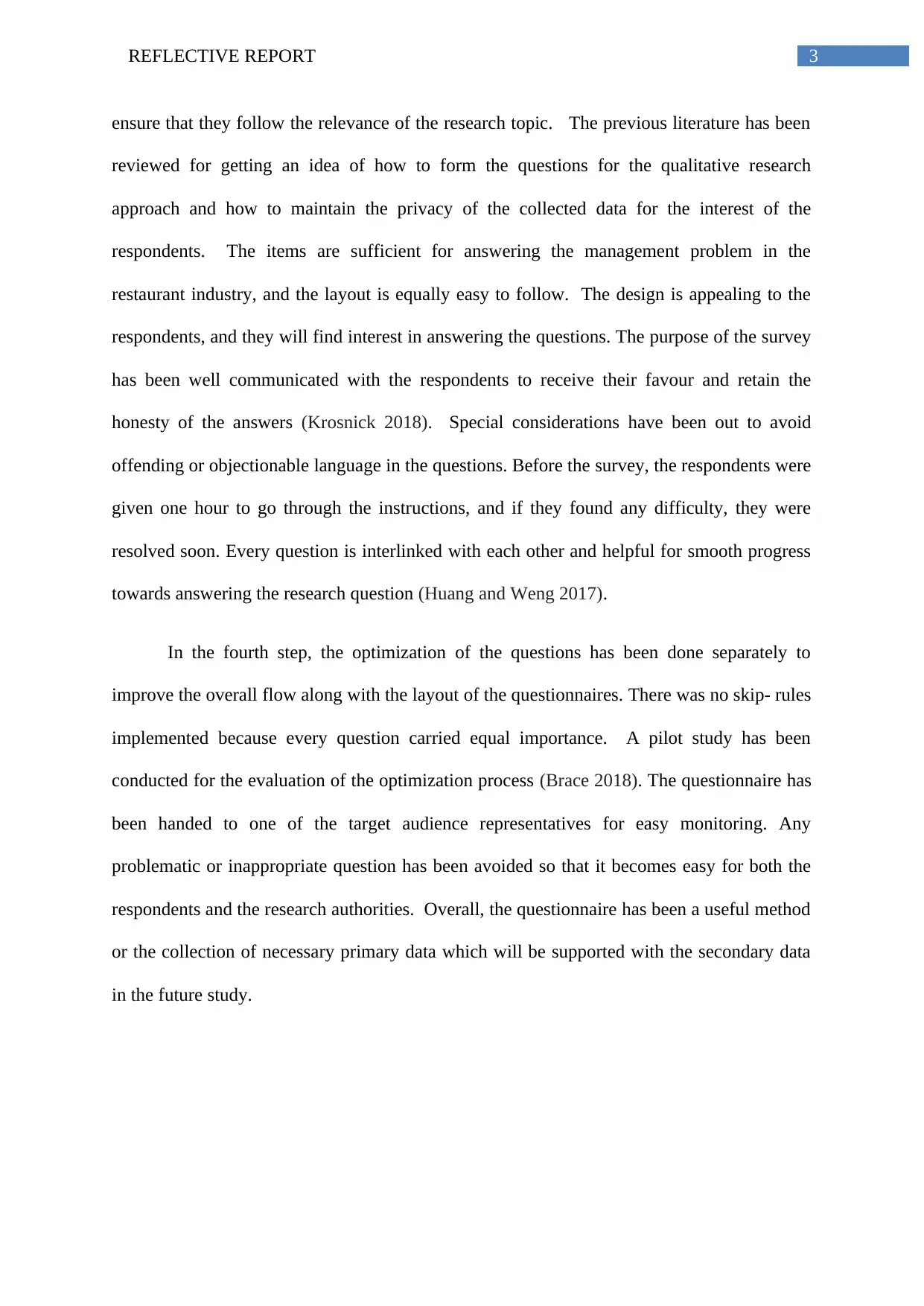
3REFLECTIVE REPORT
ensure that they follow the relevance of the research topic. The previous literature has been
reviewed for getting an idea of how to form the questions for the qualitative research
approach and how to maintain the privacy of the collected data for the interest of the
respondents. The items are sufficient for answering the management problem in the
restaurant industry, and the layout is equally easy to follow. The design is appealing to the
respondents, and they will find interest in answering the questions. The purpose of the survey
has been well communicated with the respondents to receive their favour and retain the
honesty of the answers (Krosnick 2018). Special considerations have been out to avoid
offending or objectionable language in the questions. Before the survey, the respondents were
given one hour to go through the instructions, and if they found any difficulty, they were
resolved soon. Every question is interlinked with each other and helpful for smooth progress
towards answering the research question (Huang and Weng 2017).
In the fourth step, the optimization of the questions has been done separately to
improve the overall flow along with the layout of the questionnaires. There was no skip- rules
implemented because every question carried equal importance. A pilot study has been
conducted for the evaluation of the optimization process (Brace 2018). The questionnaire has
been handed to one of the target audience representatives for easy monitoring. Any
problematic or inappropriate question has been avoided so that it becomes easy for both the
respondents and the research authorities. Overall, the questionnaire has been a useful method
or the collection of necessary primary data which will be supported with the secondary data
in the future study.
ensure that they follow the relevance of the research topic. The previous literature has been
reviewed for getting an idea of how to form the questions for the qualitative research
approach and how to maintain the privacy of the collected data for the interest of the
respondents. The items are sufficient for answering the management problem in the
restaurant industry, and the layout is equally easy to follow. The design is appealing to the
respondents, and they will find interest in answering the questions. The purpose of the survey
has been well communicated with the respondents to receive their favour and retain the
honesty of the answers (Krosnick 2018). Special considerations have been out to avoid
offending or objectionable language in the questions. Before the survey, the respondents were
given one hour to go through the instructions, and if they found any difficulty, they were
resolved soon. Every question is interlinked with each other and helpful for smooth progress
towards answering the research question (Huang and Weng 2017).
In the fourth step, the optimization of the questions has been done separately to
improve the overall flow along with the layout of the questionnaires. There was no skip- rules
implemented because every question carried equal importance. A pilot study has been
conducted for the evaluation of the optimization process (Brace 2018). The questionnaire has
been handed to one of the target audience representatives for easy monitoring. Any
problematic or inappropriate question has been avoided so that it becomes easy for both the
respondents and the research authorities. Overall, the questionnaire has been a useful method
or the collection of necessary primary data which will be supported with the secondary data
in the future study.
Paraphrase This Document
Need a fresh take? Get an instant paraphrase of this document with our AI Paraphraser
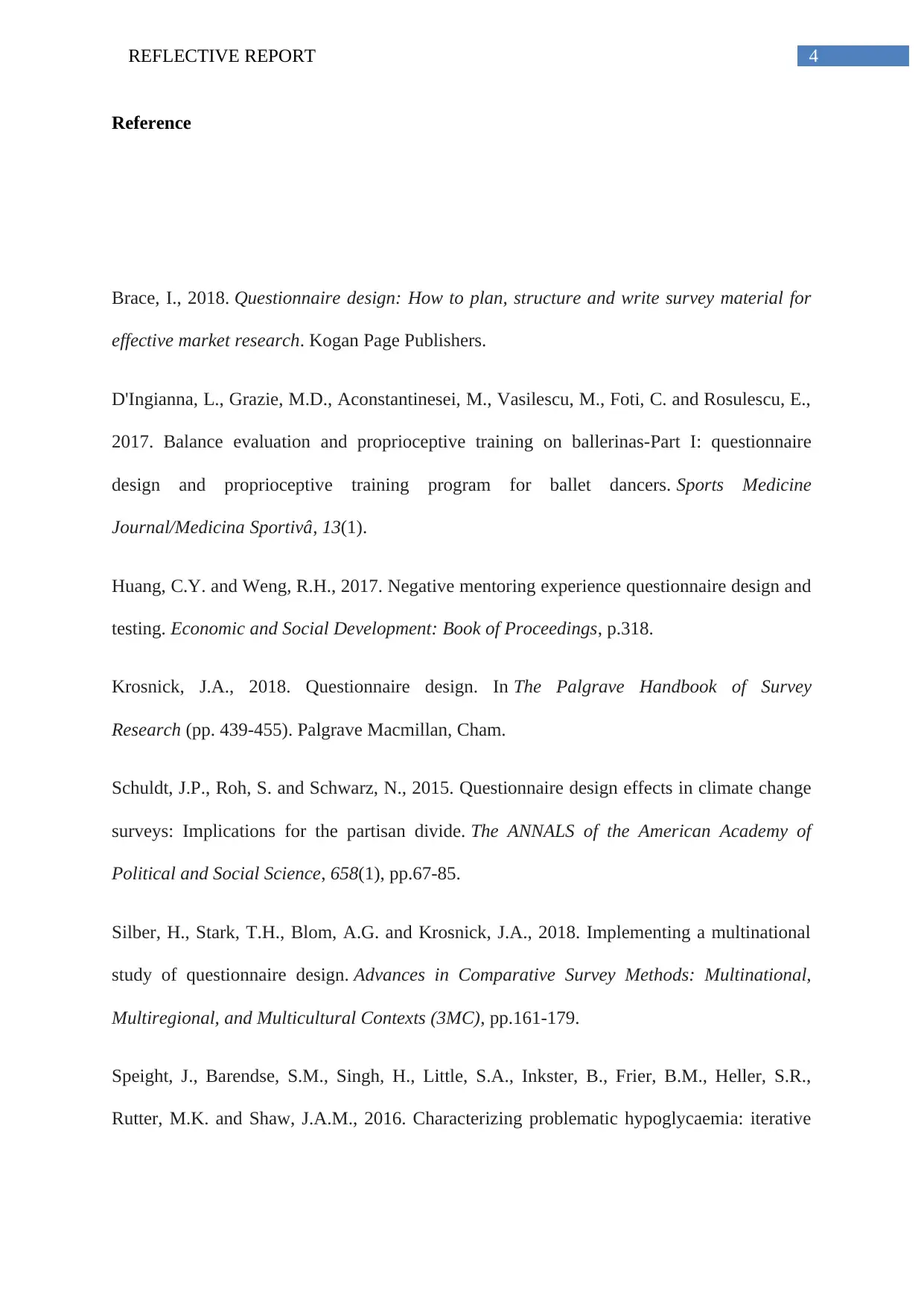
4REFLECTIVE REPORT
Reference
Brace, I., 2018. Questionnaire design: How to plan, structure and write survey material for
effective market research. Kogan Page Publishers.
D'Ingianna, L., Grazie, M.D., Aconstantinesei, M., Vasilescu, M., Foti, C. and Rosulescu, E.,
2017. Balance evaluation and proprioceptive training on ballerinas-Part I: questionnaire
design and proprioceptive training program for ballet dancers. Sports Medicine
Journal/Medicina Sportivâ, 13(1).
Huang, C.Y. and Weng, R.H., 2017. Negative mentoring experience questionnaire design and
testing. Economic and Social Development: Book of Proceedings, p.318.
Krosnick, J.A., 2018. Questionnaire design. In The Palgrave Handbook of Survey
Research (pp. 439-455). Palgrave Macmillan, Cham.
Schuldt, J.P., Roh, S. and Schwarz, N., 2015. Questionnaire design effects in climate change
surveys: Implications for the partisan divide. The ANNALS of the American Academy of
Political and Social Science, 658(1), pp.67-85.
Silber, H., Stark, T.H., Blom, A.G. and Krosnick, J.A., 2018. Implementing a multinational
study of questionnaire design. Advances in Comparative Survey Methods: Multinational,
Multiregional, and Multicultural Contexts (3MC), pp.161-179.
Speight, J., Barendse, S.M., Singh, H., Little, S.A., Inkster, B., Frier, B.M., Heller, S.R.,
Rutter, M.K. and Shaw, J.A.M., 2016. Characterizing problematic hypoglycaemia: iterative
Reference
Brace, I., 2018. Questionnaire design: How to plan, structure and write survey material for
effective market research. Kogan Page Publishers.
D'Ingianna, L., Grazie, M.D., Aconstantinesei, M., Vasilescu, M., Foti, C. and Rosulescu, E.,
2017. Balance evaluation and proprioceptive training on ballerinas-Part I: questionnaire
design and proprioceptive training program for ballet dancers. Sports Medicine
Journal/Medicina Sportivâ, 13(1).
Huang, C.Y. and Weng, R.H., 2017. Negative mentoring experience questionnaire design and
testing. Economic and Social Development: Book of Proceedings, p.318.
Krosnick, J.A., 2018. Questionnaire design. In The Palgrave Handbook of Survey
Research (pp. 439-455). Palgrave Macmillan, Cham.
Schuldt, J.P., Roh, S. and Schwarz, N., 2015. Questionnaire design effects in climate change
surveys: Implications for the partisan divide. The ANNALS of the American Academy of
Political and Social Science, 658(1), pp.67-85.
Silber, H., Stark, T.H., Blom, A.G. and Krosnick, J.A., 2018. Implementing a multinational
study of questionnaire design. Advances in Comparative Survey Methods: Multinational,
Multiregional, and Multicultural Contexts (3MC), pp.161-179.
Speight, J., Barendse, S.M., Singh, H., Little, S.A., Inkster, B., Frier, B.M., Heller, S.R.,
Rutter, M.K. and Shaw, J.A.M., 2016. Characterizing problematic hypoglycaemia: iterative
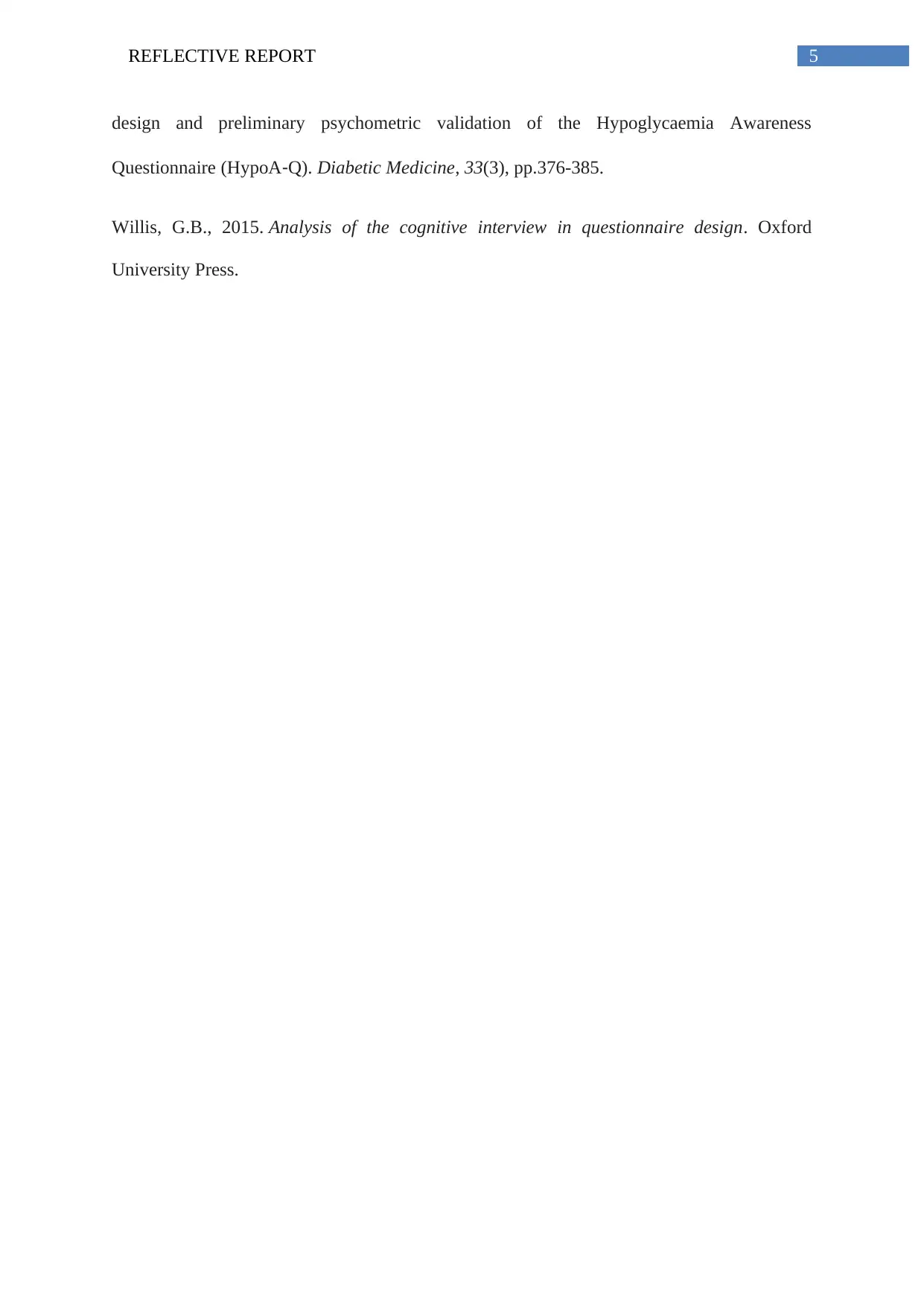
5REFLECTIVE REPORT
design and preliminary psychometric validation of the Hypoglycaemia Awareness
Questionnaire (HypoA‐Q). Diabetic Medicine, 33(3), pp.376-385.
Willis, G.B., 2015. Analysis of the cognitive interview in questionnaire design. Oxford
University Press.
design and preliminary psychometric validation of the Hypoglycaemia Awareness
Questionnaire (HypoA‐Q). Diabetic Medicine, 33(3), pp.376-385.
Willis, G.B., 2015. Analysis of the cognitive interview in questionnaire design. Oxford
University Press.
⊘ This is a preview!⊘
Do you want full access?
Subscribe today to unlock all pages.

Trusted by 1+ million students worldwide
1 out of 6
Related Documents
Your All-in-One AI-Powered Toolkit for Academic Success.
+13062052269
info@desklib.com
Available 24*7 on WhatsApp / Email
![[object Object]](/_next/static/media/star-bottom.7253800d.svg)
Unlock your academic potential
Copyright © 2020–2025 A2Z Services. All Rights Reserved. Developed and managed by ZUCOL.





